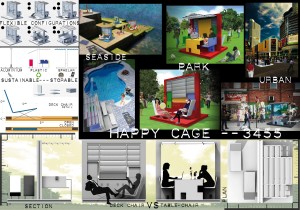3455
HAPPY CAGE
The conceptual design consists in a whole system, mainly composed by two planes, one working as a base and horizontal structure and the other defining the vertical structure: these two main elements contain all the parts needed to achieve the final composition.
The global size of the object is virtually inscribable in a 2.4-metre sided cube, as the two planes set up together open in an inverse T configuration. The horizontal plane behaves as a basement, shaped by the light aluminum structure and containing four extractable deck chairs, two in each half of the structure. The vertical element is slightly more complex, as it is filled with the majority of elements: the table, split in two parts, four seats with chair back, sunshades and electricity wiring. The choice of materials is guided by the sustainability concept, focusing upon the use of completely reused and reusable raw materials, such as aluminum for structural elements and plastic polymers (PVC) for fillings and panels of the other parts.
The shading device is composed by a series of reclining and variable shutters, so that users can actually decide the quantity of light or shadow to sit under. The shutters are superficially paneled with an innovative material, sphelar, made up by silicon spheres cast in a transparent plastic matrix (PV), able to transform solar light captured from each direction into electrical energy. Thanks to the energy collected and stored by the sphelar system, users are enabled to use electrical devices, just plugging them. The system itself works as a charging and powering object, both practically and metaphorically speaking.
During the design phase, great attention has been paid to the idea of adaptability: the object has been thought up for easily fitting every outdoor context, public and private; it can be a lunching and dining station in a private garden or in a city park, it can be used as a sunbathing spot or as an introspective place for reading and studying intimately. It can even be used to perform several activities at a time: given the multiple configuration, both deck chairs for relaxing and table with chairs are available to users, contemporarily. Changeability and usability are stressed to an utter level, from the urban décor to the seaside, through an infinite range of possibilities.
All the several parts of the system (chairs, tables, main structure, deck chairs) are paneled in a plastic material (PVC) and are extraordinarily flexible to different uses, conveying the possibility to achieve extremely different configurations even combining different situations taking place at the same time (on one side two students can read or work on the laptop in the shade, on the other two girls can quietly sunbathe).
The change of configuration is possible thanks to a system of hinges, set upon the structure and the main frame: they make movements and rotations immediate and easy to perform single-handedly.
Some more cumbersome parts (shading system and tables) contain spring mechanisms, helping and supporting the movement: in order to open the shading device, it’s enough to unhook it from its original position inside the structural frame and slightly pulling upwards, so that spring mechanism gets activated, setting the shading device into its final horizontal position.
Deck chairs are contained in the structural base of the whole system. A drawer mechanism allows part of the floor to be removed manually, folding under the pavement surface; sheltered below that, the two parts of the deck chair (seat and back) rise and open up, ready to use.
The production of every piece is performed through industrial serialization, nonetheless a wide range of colors can be provided, in order to achieve a total creative freedom and to meet the needs for every situation and context.
Participation Information
Dario Marino
CODE 3455
EDUCATIONAL INSTITUTE: University Of Pavia (Italy)




